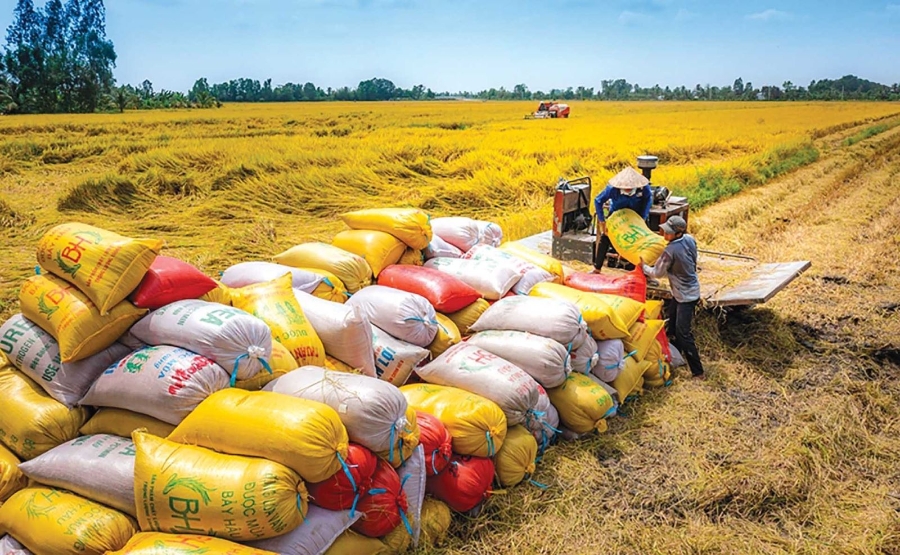
According to the report from the Ministry of Agriculture and Environment, in the first eight months of 2025, Vietnam's total rice export volume reached 6.3 million tons, equivalent to 3.17 billion USD, up 2.2% in volume but down 17.5% in value compared to the same period in 2024. This indicates a sharp decline in export value, posing a worrying issue for businesses and farmers in the sector.
EXPORT RICE PRICES DROP SHARPLY
In the first eight months of 2025, the Philippines remained Vietnam's largest rice consumer market, accounting for 42% of total exports. However, export value to this market decreased by 16% compared to the same period last year. Notably, from September 1, 2025, the Philippines decided to suspend imports of regular and milled rice for 60 days, excluding specialty rice varieties. This decision not only affects exporters’ revenues but also creates significant pressure on domestic prices and supply.
Vietnam's average export rice price in the first eight months of 2025 was estimated at 504.9 USD/ton, down 19.3% compared to the same period in 2024. This price drop was driven not only by reduced international demand but also by fierce competition from other rice-exporting countries such as India, Thailand, and Pakistan.
Specifically, in August 2025, Thailand's 5% broken rice price dropped by 16 USD/ton to 354 USD/ton; its 100% white rice type B fell by 16 USD/ton to 364 USD/ton; 25% broken rice plunged 20 USD/ton to just 333 USD/ton.
Meanwhile, in Vietnam, 5% broken rice peaked at 395 USD/ton (highest on August 20) before falling back to 389 USD/ton; 25% broken rice rose to 371 USD/ton, now down to 367 USD/ton; 100% broken rice climbed to 339 USD/ton, currently 333 USD/ton; premium Jasmine rice rose to 561 USD/ton, now 545 USD/ton.
In India, 5% broken rice decreased by 2 USD/ton to 376 USD/ton; 25% broken rice fell by 2 USD/ton to 360 USD/ton; 5% parboiled rice (STXD) dropped 11 USD/ton to 364 USD/ton. In Pakistan, 5% broken rice fell sharply by 17 USD/ton to 353 USD/ton; 25% broken rice by 14 USD/ton to 335 USD/ton; 100% broken parboiled rice (STXD) by 10 USD/ton to 307 USD/ton.
RESPONDING TO NEW DEVELOPMENTS
In light of the Philippines’ decision to suspend imports of regular and milled rice for 60 days (excluding specialty rice), the Ministry of Industry and Trade issued a document to provincial and city People's Committees, the Vietnam Food Association (VFA), and rice exporters, urging urgent adjustment of production and business plans and diversification of consumption markets.
"The suspension by the Philippines requires enterprises and localities to quickly grasp and update policy information to avoid disruption risks. Local authorities need to consolidate feedback from the business community on difficulties and promptly report to develop response solutions," emphasized the Ministry’s document, which also requested VFA to inform members early to support export adjustments.
The Ministry also stressed the need to closely monitor domestic and international rice market developments and coordinate tightly with the Philippines’ rice import association to timely update policies, thereby proposing measures to promote domestic rice consumption and stabilize exports.
Despite many challenges, Vietnam still has significant opportunities to maintain growth momentum in rice exports. Many international partners, including the US, Singapore, and Brazil, appreciate Vietnam’s role in the global rice supply chain, especially in the high-quality rice segment. This shows that although the Philippines is an important market, Vietnam can still explore and develop other potential markets.
Mr. Phung Duc Tien, Deputy Minister of Agriculture and Environment, stated that Vietnam has played a crucial role in global food security. With large export values, Vietnam's position in the international market continues to be affirmed. In 2024, Vietnam exported approximately 9 million tons of rice, earning 5.7 billion USD, keeping it among the world’s leading rice exporters.
Mr. Le Ba Anh, Deputy Director of the Department of Quality, Processing, and Market Development (Ministry of Agriculture and Environment), noted that Presidential Decree No. 93 from the Philippines suspends rice imports for 60 days to protect the country's harvest during this period.
“Although the suspension lasts 60 days, the Philippine Ministry of Agriculture is required to reassess the situation after 30 days and may shorten the suspension,” Mr. Le Ba Anh added.
While rice exports to the Philippines are temporarily interrupted, the Ministry reported that domestic rice prices in the first week of September 2025 remained stable. Specifically, on September 8, fresh IR 50404 rice prices ranged around 5,700–5,800 VND/kg; fresh OM 5451 rice traded at 5,900–6,000 VND/kg; fresh IR 4625 glutinous rice ranged from 7,300–7,500 VND/kg. Vietnam’s export rice prices showed no new fluctuations.
“In this context, rice exporters need to proactively develop suitable production plans and rapidly seek and expand new potential markets to diversify risks and enhance adaptability to international trade fluctuations. Proactivity and flexibility in business strategies will be decisive factors helping Vietnam’s rice sector overcome this difficult phase and continue sustainable development in the future,” emphasized Deputy Minister Phung Duc Tien.
Source: vneconomy.vn




